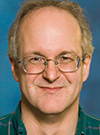Ermentrout Receives Math-Neuroscience Prize
G. Bard Ermentrout was at a conference in South Africa in February when he got the news: He had won Israel Brain Technologies’ $100,000 Mathematical Neuroscience Prize.
“I knew I had been nominated, and they said they’d announce the winners in December,” he says. “That time passed. I was in South Africa thinking, ‘I wonder who got it.’”
Then he checked his email: “Holy cow, I got it! I walked out into the hall and said that about six times!’”
 Ermentrout—the University Professor of Computational Biology and professor of mathematics—has made a career of using math to understand biological systems and processes. In particular, he has focused on neuroscience, using mathematics principles to decipher and understand activity patterns in networks of neurons. He developed simulation software, XPPAUT, that allows the less mathematically sophisticated to visualize complex processes vital to neuroscience, enabling the exploration of dynamical systems. The software has been cited by others in more than 1,000 research papers.
Ermentrout—the University Professor of Computational Biology and professor of mathematics—has made a career of using math to understand biological systems and processes. In particular, he has focused on neuroscience, using mathematics principles to decipher and understand activity patterns in networks of neurons. He developed simulation software, XPPAUT, that allows the less mathematically sophisticated to visualize complex processes vital to neuroscience, enabling the exploration of dynamical systems. The software has been cited by others in more than 1,000 research papers.
“This has really been a nice surprise,” he says about the award, which honors researchers worldwide who have significantly advanced an understanding of the neural mechanisms of perception, behavior, and thought through the application of mathematical analysis and theoretical modeling. The prize presenters noted, in particular, Ermentrout’s “classic work in mathematical biology.” A research colleague at Boston University, Nancy Kopell, also won a 2015 IBT Mathematical Neuroscience Prize and $100,000.
The award-winning Pitt mathematician has published seminal work on neural oscillation, the rhythmic or repetitive neural activity in the central nervous system, an activity vital to processing neural information. His research has explored neuroprocesses such as neural firing patterns and the mechanisms of visual hallucinations.
Back in South Africa, shortly before finding out that he was getting $100,000 as recognition for his life’s work, he survived another surprise: a near encounter with a feisty Chacma baboon.
As good hosts do, Ermentrout’s South African host organized a sightseeing field trip with a few colleagues. In a rented SUV, they headed out to view some penguins. Maybe climb up a lighthouse and take in the scenery. With that accomplished, the group decided to visit the beach.
“All around the beach there were warning signs posted that there were baboons around and that you should keep your things secure,” recalls Ermentrout. This was true. There were plenty of baboons afoot. “I saw one steal a bag from an elderly couple’s blanket,” he says. “I even got some video of the guy trying to get his stuff back.”
Then, Ermentrout’s host returned to the vehicle. Next, says Ermentrout, the host was yelling that baboons had gotten in the SUV. “There were two or three in there ransacking the car, looking for snacks,” says Ermentrout. He banged on a window with a beach chair, which chased one of the baboons out. Eventually, in the ensuing commotion, the car emptied. “We managed to close the other door, and then had a bit of cleanup to do, but it wasn’t bad,” he concludes.
No word as to whether Ermentrout will embark on a new career path studying the thieving habits of Papio ursinus.
Other Stories From This Issue
On the Freedom Road

Follow a group of Pitt students on the Returning to the Roots of Civil Rights bus tour, a nine-day, 2,300-mile journey crisscrossing five states.
Day 1: The Awakening
Day 2: Deep Impressions
Day 3: Music, Montgomery, and More
Day 4: Looking Back, Looking Forward
Day 5: Learning to Remember
Day 6: The Mountaintop
Day 7: Slavery and Beyond
Day 8: Lessons to Bring Home
Day 9: Final Lessons

